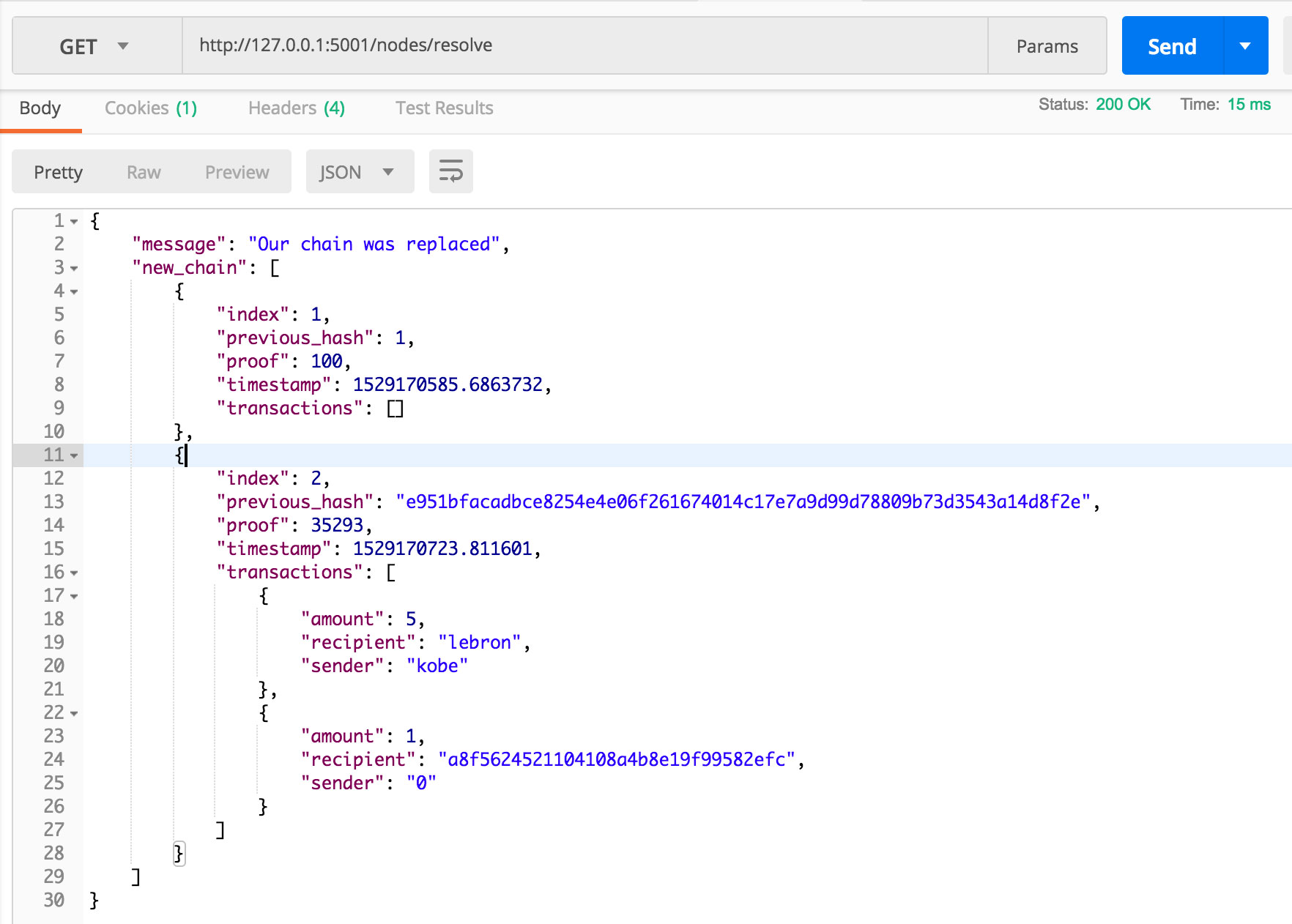密码朋克Cyberpunk:数字资产发行
比特币-数字货币(共识机制),去中心化的记账系统
- 财产只受自己控制
- 无通胀
- 没有假钞
- 流通性好
工作量证明(Proof of Work):获得唯一记账权,Hash前置18个0,理论上需进行1618次计算,获取记账权将获得奖励
接下来我们使用 Python 及 Flask 框架实现基础的区块链架构,包含区块的创建、工作量证明、交易接口、挖矿接口、共识机制及多节点的模拟实现。
安装环境
|
1 2 3 4 5 6 7 8 9 |
mkdir blockchain cd blockchain pip install pipenv pipenv --python=python3.6 pipenv install flask pipenv install requests # 查看解释器所在位置 pipenv --py |
以下我们以前置4个0来进行测试说明
|
1 2 3 4 5 6 7 8 9 10 11 12 13 14 15 16 17 18 19 20 21 22 23 24 25 26 27 28 29 30 31 32 33 34 35 36 37 38 39 40 41 42 43 44 45 46 47 48 49 50 51 52 53 54 55 56 57 58 59 60 61 62 63 64 65 66 67 68 69 70 71 72 73 74 75 76 77 78 79 80 81 82 83 84 85 86 87 88 89 90 91 92 93 94 95 96 97 98 99 100 101 102 103 104 105 106 107 108 109 110 111 112 113 114 115 116 117 118 119 120 121 122 123 124 125 126 127 128 129 130 131 132 133 134 135 136 137 138 139 140 141 142 143 144 145 146 147 148 149 150 151 152 153 154 155 156 157 158 159 160 161 162 163 164 165 166 167 168 169 170 171 172 173 174 175 176 177 178 179 180 181 182 183 184 185 186 187 188 189 190 191 192 193 194 195 196 197 198 199 200 201 202 203 204 205 206 207 208 209 210 211 212 213 214 215 216 217 218 219 220 221 222 223 224 225 226 227 228 229 230 231 232 233 234 |
import hashlib import json from argparse import ArgumentParser from time import time from urllib.parse import urlparse from uuid import uuid4 import requests from flask import Flask, jsonify from flask import request # { # "index": 0, # "timestamp": "", # "transactions": [ # "sender": "", # "recipient": "", # "amount": 5, # ], # "proof": "", # "previous_hash": "" # } class Blockchain: def __init__(self): self.chain = [] self.current_transactions = [] self.nodes = set() self.new_block(proof=100, previous_hash=1) def register_node(self, address: str): parsed_url = urlparse(address) self.nodes.add(parsed_url.netloc) def valid_chain(self, chain) -> bool: last_block = chain[0] current_index = 1 while current_index < len(chain): block = chain[current_index] if block['previous_hash'] != self.hash(last_block): return False if not self.valid_proof(last_block['proof'], block['proof']): return False last_block = block current_index += 1 return True def resolve_conflicts(self) -> bool: neighbours = self.nodes max_len = len(self.chain) new_chain = None # 遍历相邻节点 for node in neighbours: response = requests.get(f'http://{node}/chain') if response.status_code == 200: length = response.json()['length'] chain = response.json()['chain'] # 比当前链更长并且是一个有效链 if length > max_len and self.valid_chain(chain): max_len = length new_chain = chain if new_chain: self.chain = new_chain return True return False def new_block(self, proof, previous_hash=None): """ 创建一个区块 """ block = { 'index': len(self.chain) + 1, 'timestamp': time(), 'transactions': self.current_transactions, 'proof': proof, 'previous_hash': previous_hash or self.hash(self.last_block) } self.current_transactions = [] self.chain.append(block) return block def new_transaction(self, sender, recipient, amount) -> int: """ 添加交易 """ self.current_transactions.append( { 'sender': sender, 'recipient': recipient, 'amount': amount } ) return self.last_block['index'] + 1 @staticmethod def hash(block): block_string = json.dumps(block, sort_keys=True).encode() # 返回Hash后的摘要信息 return hashlib.sha256(block_string).hexdigest() @property def last_block(self): return self.chain[-1] def proof_of_work(self, last_proof: int) -> int: """ 工作量证明 """ proof = 0 while self.valid_proof(last_proof, proof) is False: proof += 1 print(proof) return proof def valid_proof(self, last_proof: int, proof: int) -> bool: guess = f'{last_proof}{proof}'.encode() guess_hash = hashlib.sha256(guess).hexdigest() print(guess_hash) return guess_hash[0:4] == "0000" # testPow = Blockchain() # testPow.proof_of_work(100) blockchain = Blockchain() app = Flask(__name__) node_identifier = str(uuid4()).replace('-', '') @app.route('/transactions/new', methods=['POST']) def new_transaction(): values = request.get_json() required = ["sender", "recipient", "amount"] if values is None: return "Missing values", 400 if not all(k in values for k in required): return "Missing values", 400 index = blockchain.new_transaction(values['sender'], values['recipient'], values['amount']) response = {"message": f'Transaction will be added to block {index}'} return jsonify(response), 201 @app.route('/mine', methods=["GET"]) def mine(): last_block = blockchain.last_block last_proof = last_block['proof'] proof = blockchain.proof_of_work(last_proof) blockchain.new_transaction(sender="0", recipient=node_identifier, amount=1) block = blockchain.new_block(proof, None) response = { "message": "New Block Forged", "index": block['index'], "transactions": block["transactions"], "proof": block["proof"], "previous_hash": block["previous_hash"] } return jsonify(response), 200 @app.route('/chain', methods=['GET']) def full_chain(): response = { 'chain': blockchain.chain, 'length': len(blockchain.chain) } return jsonify(response), 200 @app.route('/nodes/register', methods=['POST']) def register_nodes(): # "nodes": ["http://127.0.0.1:5002"] values = request.get_json() nodes = values.get("nodes") if nodes is None: return "Error: please supply a valid list of nodes", 400 for node in nodes: blockchain.register_node(node) response = { "message": "New nodes have been added", "total_nodes": list(blockchain.nodes) } return jsonify(response), 201 @app.route('/nodes/resolve', methods=['GET']) def consensus(): replaced = blockchain.resolve_conflicts() if replaced: response = { 'message': 'Our chain was replaced', 'new_chain': blockchain.chain } else: response = { 'message': 'Our chain is authoritative', 'chain': blockchain.chain } return jsonify(response), 200 if __name__=="__main__": parser = ArgumentParser() # 命令行中自定义端口 parser.add_argument('-p', '--port', default=5000, type=int, help='port to listen to') args = parser.parse_args() port = args.port app.run(host="0.0.0.0", port=port) |
下图为采用5000和5001两个端口的节点,对5000端口添加交易(/transactions/new)并挖矿(/mine),链长为2,然后分别对两个端口进行注册(/nodes/register)
最终根据链长来进行替换:







